8 July 2022
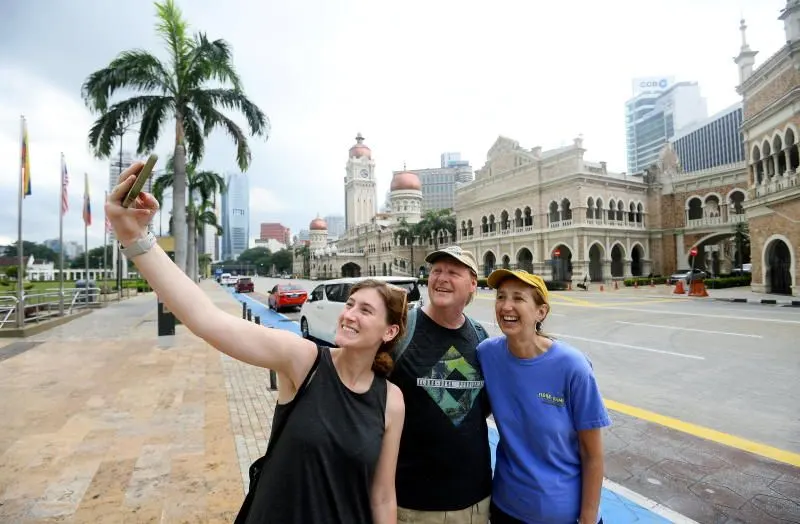
With tourists flocking to Malaysia again following the re-opening of the country’s borders, many are hoping that the industry will quickly recover.
The closure of Malaysia’s borders due to Covid-19 slowed tourism to a near standstill, with arrivals shrinking from 26.1 million in 2019 to 134,728 in 2021.
The good news is that tourist arrivals to Malaysia has picked up since the borders re-opened in April, hitting two million this year on June 21.
The current target is to draw 4.5 million tourists this year, with the figure to be reviewed in September.
Here’s a snapshot of how the pandemic battered tourism in Malaysia and the rest of Asean, what the recovery looks like and what’s needed to get the industry fully back on track.
Hit from all sides
Tourist arrivals to all countries including in Asean were hit by the pandemic.
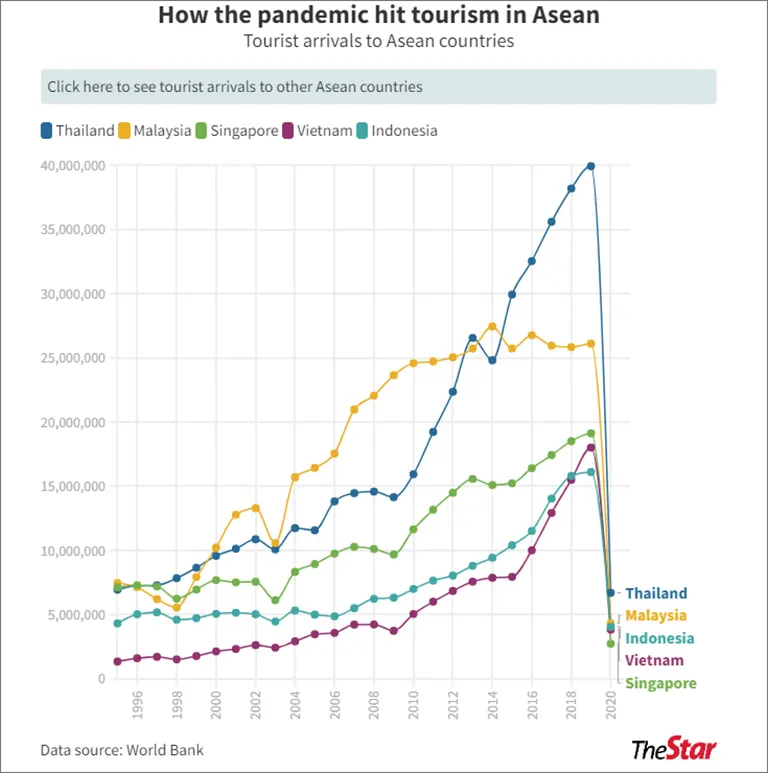
The reopening of the country’s borders has led to an influx of tourists.
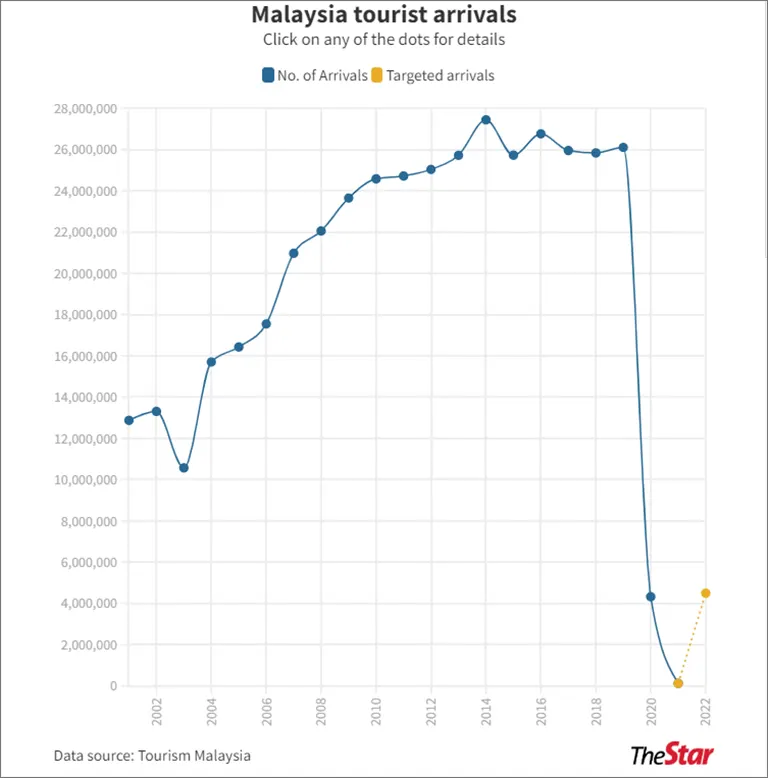
Malaysia tourist arrivals by source country.
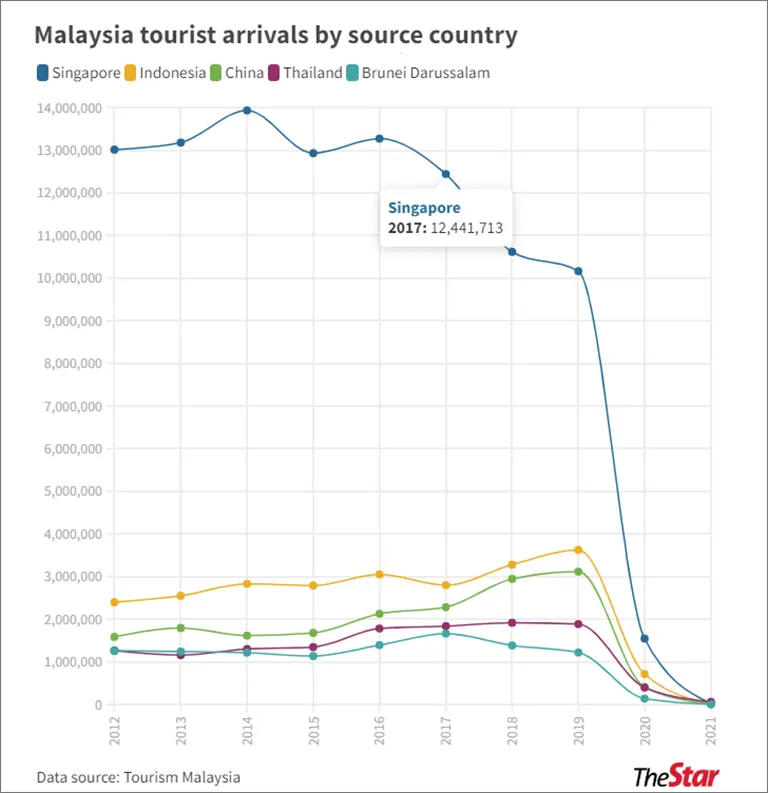
Since Malaysia reopened its borders, Johor’s Senai International Airport and Sabah’s Kota Kinabalu international Airport have been ranked among the busiest in South-East Asia.
Global travel data firm OAG ranked Senai as the fourth fastest growing international airport in the region in June, while Kota Kinabalu landed in ninth spot.
According to OAG’s South-East Asia Aviation Market Report for June 2022, the number of seats for international flights departing Johor Baru grew last month (June) by 74% to 8,460 compared to May.
Kota Kinabalu recorded a 28% rise in the number of seats to 15,920.
In first place was Vietnam’s Cam Ranh International Airport which saw a 429% jump in seats.
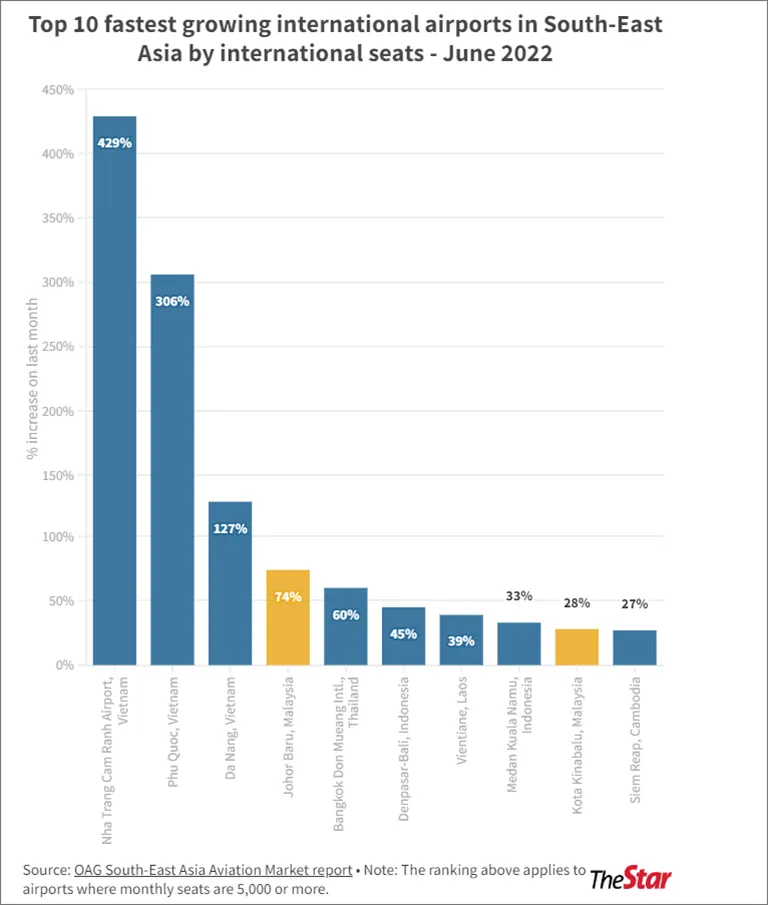
In terms of the total number of departing seats, Kuala Lumpur International Airport was ranked seventh in South-East Asia with 1.35 million seats in June.
Indonesia’s Soekarno-Hatta International Airport topped the region with three million seats.
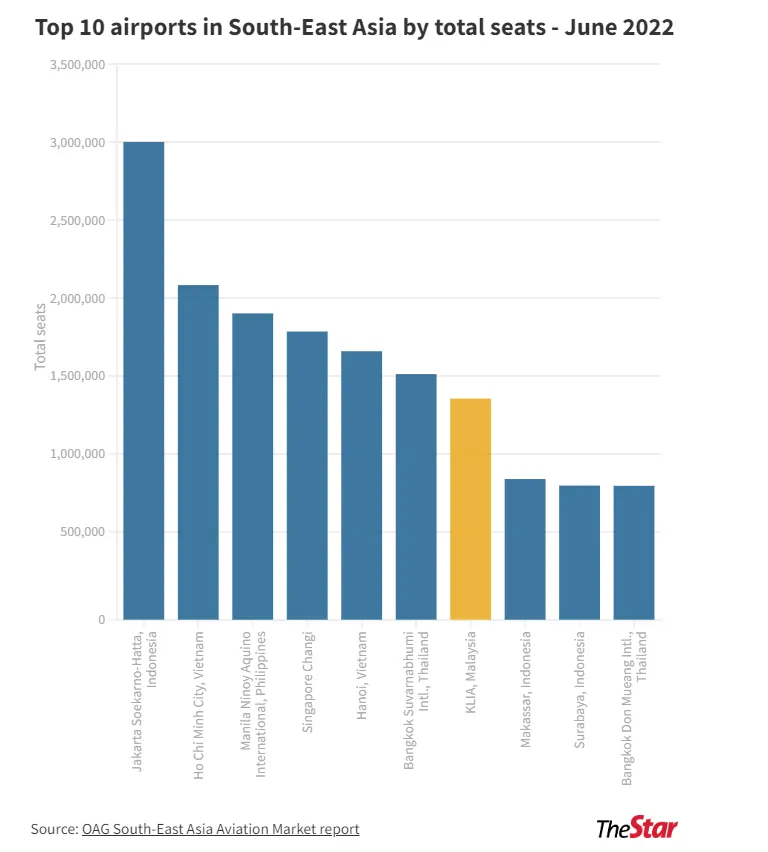
The Kuala Lumpur to Singapore air route was meanwhile ranked as the world’s second busiest route for the June 2022 period with 271,886 seats.
In first place was New York JFK to London Heathrow, with 281,375 seats.
For the South-East Asian region, the Penang to Singapore route was the 10th busiest with 78,360 seats.
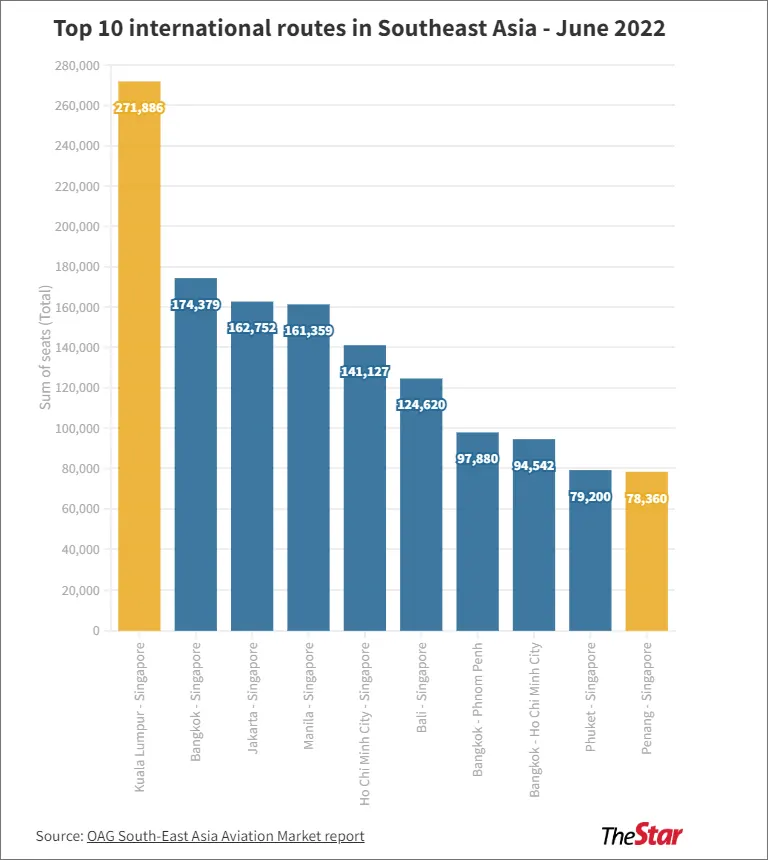
Challenges ahead
Mayur Patel, OAG Aviation’s head of Asia, said South-East Asia faced a number of constraints in further ramping up its air travel recovery to pre-pandemic levels.
“Until we see China once again freely allowing international services, many airlines will struggle to increase capacity beyond what we see today.
“Airlines in the region also face a number of resource challenges in terms of aircraft availability and qualified staff, which add further complexity to any more of a recovery,” he added.
Malaysian Association of Tour and Travel Agents (MATTA) president Datuk Tan Kok Liang said he is positive that Malaysia can meet its 4.5-million tourist arrival target despite various challenges faced by the industry.
He said MATTA had forecast the arrival of five million tourists by the end of the year.
“However, the target is dependent on arrivals from the Asean market, as well as from India and South Korea,” he said.
Tan said public-private partnership needs to be further enhanced by targeting marketing efforts with specific products offerings and segmentalisation.
He said the inflow of tourists needs to be better managed, such as at immigration counters where long waiting times and queues would affect tourist satisfaction.
Tan said other challenges such as high airfare costs, limited options on air connectivity and Covid-19 test requirements in other countries might dissuade tourist arrivals.
“Challenges in Malaysia include escalating operations costs, lack of staff and increase in salary costs,” he said.
To encourage tourist arrivals, Tan suggested the industry target specific markets and special interest groups such as business event groups, medical tourism, as well as high-end leisure holidaymakers and consumers.
“We can target these groups with specific and tailor-made product offerings.
“We must also look into charter flights while waiting for the resumption of more scheduled flights,” he said.
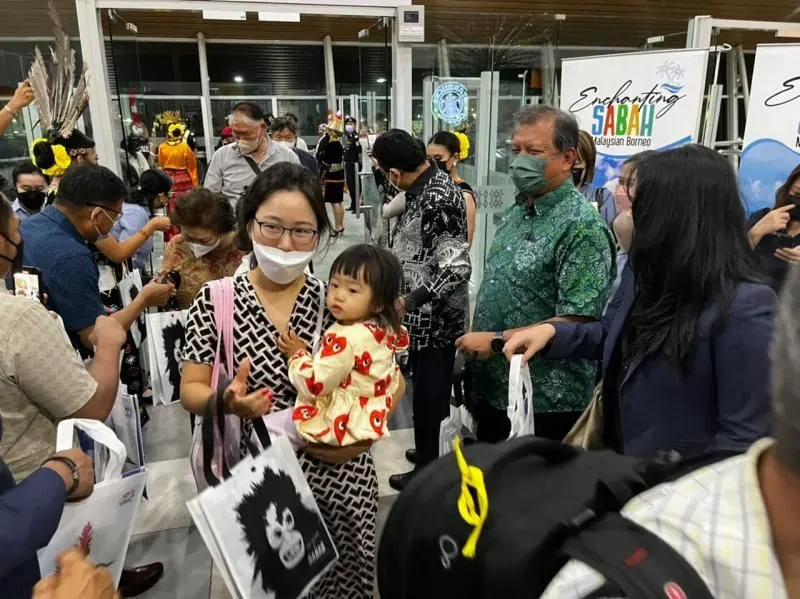
Malaysian Association of Hotels (MAH) president Christina Toh said tourists, especially from Asean countries, have started to arrive in the country since the reopening of borders in April.
“Singapore was the first to catch on, followed by Indonesia, and others like Thailand, Cambodia and Vietnam.
“We are truly enjoying the tourist arrivals coming from these country zones,” she added.
She said tourist arrivals from Britain and Europe would take time due to the current limitation of flights.
Toh said she is confident that the hotel industry can easily hit the 4.5-million tourist arrival target.
“We have been receiving a lot of enquiries and each of the state tourism and tourism and hospitality bodies have started working hand in hand to reach out to leisure groups and meeting-conference incentive groups.
“Of course, everybody is also waiting for China to reopen,” she said.
On the manpower shortage affecting the hotel industry, Toh said hotel businesses are managing occupancy in accordance with their manpower capability to avoid compromising services.
“We are managing our business in accordance with the manpower capability that we have,” she said, adding that there has been a slight improvement recently in people looking for jobs in the hotel industry.
She expected that the situation would improve by the first quarter of next year.
Malaysia Budget Hotel Association national deputy president Dr Sri Ganesh Michiel said tourism threats such as unlicensed operators need to be eradicated for the country’s tourism industry to recover.
He said there are no regulations that govern online travel agencies and short-term rental accommodations.
“The arrival of tourists is increasing but this is not helping the hotel industry as tourists choose to stay at short term rental accommodations.
“The hotel industry will only recover after the government acts on these threats,” he said, adding that the presence of illegal businesses will cause licensed operators to lose out, while impacting the government’s tax revenue.
Source: www.thestar.com.my
Site Search
Did you find what you are looking for? Try out the enhanced Google Search: